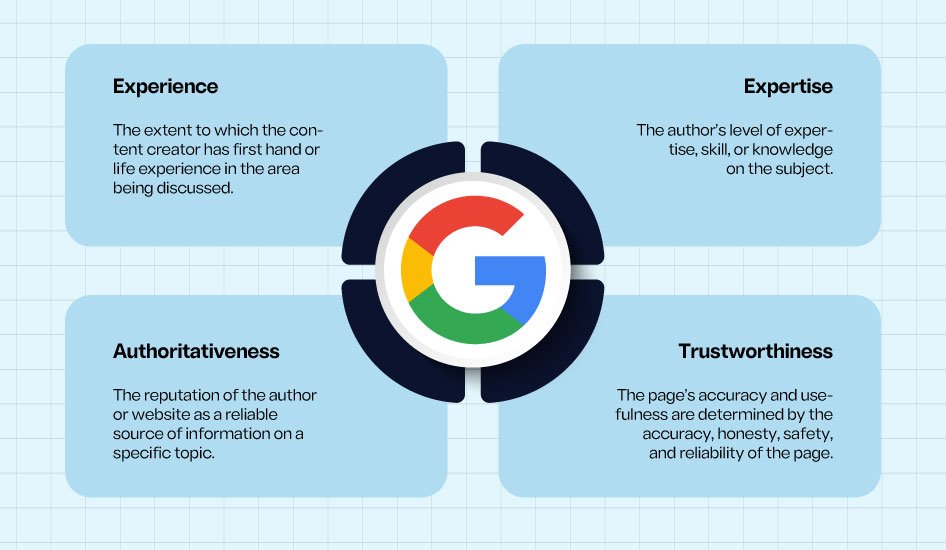What is E-E-A-T & Why it’s Important for SEO?

E-A-T stands for Expertise, Authoritativeness, and Trustworthiness. It’s a concept that Google uses to evaluate the quality of websites and their content. E-A-T is important for SEO because it’s a signal to Google that your website is a reliable source of information.
If you need help improving your website’s E-A-T, an Organic SEO agency like NFlowTech can be a valuable resource. They can provide you with the expertise and guidance you need to improve your website’s E-A-T and achieve your SEO goals.
What is E-E-A-T?
E.E.A.T. simply stands for “Experience, Expertise, Authoritativeness, and Trustworthiness.” Before a change by Google in December 2022, it was spelt merely E-A-T (without the “Experience” prefix).

As I have just described, what is E-E-A-T, but do you know Google introduced it? Yes, in their Google Search Quality Rater Guidelines back in 2013, Google mentioned E-A-T, which was to assist web admins in understanding what Google considers essential in a web page.
Google, however, updated the term to include “Experience” in December 2022. Google uses E-E-A-T as one of many signals to determine a page’s quality. You should consider how the page’s quality will affect its rank in Google’s organic search results while writing content for your website.

According to Ahrefs, it was back in August 2018 when the world started talking about E-A-T along with SEO.
While we are clear about what is, E-E-A-T Let’s break down each term of E-E-A-T in detail:
“Expertise” refers to a significant amount of specialized knowledge in a particular area. It demonstrates that the publication has provided information from an expert.
Experience is the most recent component to be added to the E-E-A-T signals. The degree of first-hand expertise that a publisher has on a particular subject is referred to as “experience,” and the content quality is ranked in accordance with that level of experience.
The Authoritativeness characteristic highlights the credibility and standing of the website’s publisher and itself. It is influenced by expertise in a particular subject, qualifications, and evaluations from users considered credible.
Trustworthiness – demonstrates that the material was compiled using reliable sources of information.
Now that you have learned about What is E-E-A-T? Let us see why it is essential.
Why Is Google’s E-E-A-T Important for SEO?
Long gone are the days when website ranking relied upon keyword stuffing and backlinks alone; today, search engines like Google emphasize providing a positive user experience.
This user-focused approach has made E-E-A-T – Expertise, Authoritativeness, and Trustworthiness – an essential consideration for web admins looking to improve their online visibility.
My content creation revolves around three central concerns: what is the visitor looking for, will they enjoy their time on my site, and will they find value in my content?
I begin by investigating user needs via keyword usage and examining search intent. Then, I review the whole user experience by looking at both the fundamentals of the website and additional variables like interstitial, font size, etc. Finally, I evaluate whether my content meets the user’s purpose by considering whether or not it provides a complete response to the user’s question and leaves them feeling knowledgeable and fulfilled.
Web admins may boost their sites’ visibility and engagement with visitors by prioritizing creating content that satisfies these criteria.
According to their guidelines, great content should:
- Help users.
- Be created by an expert.
- Be posted on an authoritative site.
- Be trustworthy.
- Be updated regularly.
The content should be created with a high level of expertise, though “everyday expertise” from people with real-life experience is acceptable when appropriate.
Pages that spread hate cause harm, misinform, or deceive users may receive a lower E-A-T rating from search evaluators.
How to Improve Your E-E-A-T?
Now that you have completely grasped the concept of what E-E-A-T is, then now it’s time to look at how you can improve your E-E-A-T.
1. Constantly Review and Update Your Content
Every user wants to have high-quality content. High-quality content demands time, effort, expertise and skills, and when you are able to create such content, it will show your efforts.
In order to maintain high standards of E-E-A-T in your subject matter, it is important to do regular audits. Once-valuable material becomes less so when it contains facts that have since changed.
And keep making fresh posts that cater to your readers’ ever-evolving wants and requirements.
It’s a great best practice to revise content multiple times to ensure it’s accurate and current, and it may also be a way Google detects time and effort.
2. Focus On Building High-Quality Backlinks
Increasing the quantity and quality of backlinks pointing to your website is crucial for establishing credibility and authority within your industry. Collaborating with experienced professionals, such as SEOs, PR specialists, or digital marketing agencies, can assist in developing strategies to earn high-quality backlinks from influential sources.
To achieve this, create engaging content that positions your brand as a thought leader in your niche and encourages others to share and reference it. Remember that the number of backlinks is less significant than the calibre of those linking to your site.
High-quality backlinks come from established authorities recognizing your expertise in their content.
On the other hand, links embedded in graphics, buttons, or widgets typically lack substance and won’t contribute significantly to enhancing your domain’s authority. Concentrating on acquiring top-notch backlinks should be the foundation for solidifying your online reputation over time.
3. Provide and Get Positive User Reviews and testimonials.
Users rely more on user reviews, which is applicable to us. People like you and me also read reviews on online shopping sites, Amazon, and even Google!
Share authentic stories about past clients’ experiences to give potential customers a sense of what working with your business might entail. Don’t limit yourself to only featuring favorable comments – acknowledging constructive criticism can demonstrate transparency and willingness to adapt. Additionally, actively participate in discussions related to your organization on external review platforms.
Engaging with both positive and unfavorable evaluations demonstrates accountability and attentiveness to client opinions. These actions help create a reliable image for new users exploring your services or products.
4. Always Ready to Provide Contact Information and Show Support
Earning consumer trust is critical for success in any type of online venture. For eCommerce sites, providing easy access to assistance and troubleshooting resources plays a significant role in achieving this objective.
Making sure users are aware that support options exist, like listing contact details plainly or writing informative self-help guides, reassures them that aid is readily available whenever they encounter issues.
Keep in mind that even non-eCommerce sites can benefit from offering similar features since having accessible help signifies to visitors that they can rely on your platform. Ultimately, taking steps to address user concerns beforehand enhances their perception of your website’s dependability and credibility.
5. Try to Provide Author & Business Credentials and Do Avoid Clickbait Content
Boosting your website’s perceived authority requires presenting evidence of expertise and experience. Elements like author biographies or background information about your organization can play essential roles in establishing trustworthiness. When crafting author bios, highlight each contributor’s qualifications or relevant knowledge.
By doing so, readers will understand why specific individuals are qualified to write about certain subjects. Similarly, clearly convey important aspects of your enterprise, including length of operation, affiliated associations, accolades achieved, and your underlying mission.
While creating engaging headlines may seem tempting, resist the urge to resort to misleading “clickbait” tactics. Not only do these techniques harm your reputation, but they also prioritize short-term gains at the expense of long-term relationships with users.
Wrap Up
So, that is it from my end for what is E-E-A-T. I hope this information will be proven to be valuable and helpful in building an SEO strategy for your business. If you follow these steps, you will likely get excellent results on the E-E-A-T. It takes a lot of effort, but there are methods to increase a website’s E-E-A-T.







